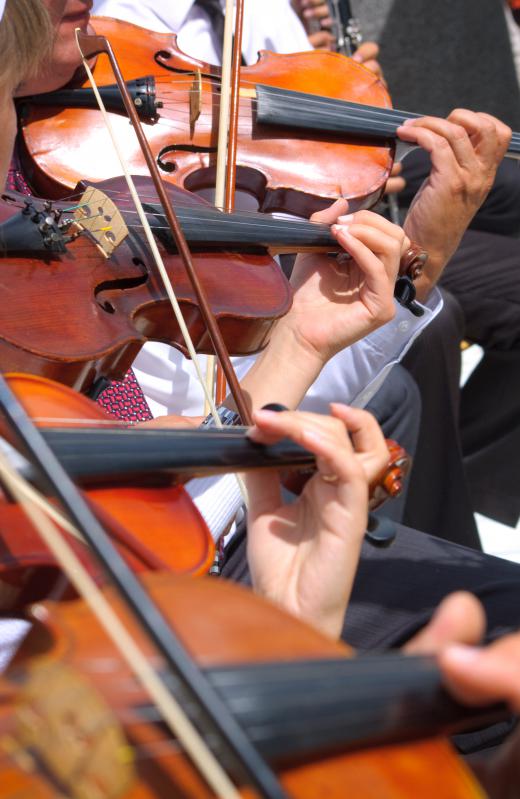An orchestra is made up of a large assortment of musicians who typically are gathered together to play classical music. The specific number of musicians is dictated by the type of orchestra and the resources available to hire players. Orchestras generally are broken up into to four groups, each of which plays a different family of instruments. These orchestra groups include strings, woodwinds, brass and percussion. The arrangement of these groups can vary significantly depending on the size of the concert hall and the type of music being performed.
Stringed instruments are the most visible of the orchestra groups, because they are typically arranged at the front of the concert stage. The strings include violins, violas, cellos and double basses. These instruments feature several strings stretched out along a hollow wooden body. Sound is produced when a bow is drawn across the strings and resonates through the wood. The string section is the largest group and provides the basic instrumentation for many musical compositions.

The woodwind section is one of the three smaller orchestra groups, and it usually is placed in the middle of the stage behind the strings. Clarinets, flutes, piccolos, oboes, English horns, bass clarinets, bassoons and contra-bassoons are the woodwinds commonly seen in an orchestra. Woodwind players perform by blowing into their instruments and modifying the acoustics with a set of keys arranged along the length of the instrument. Some woodwinds, such as clarinets, are partially constructed from wood, while others are composed entirely from metal.

Brass instruments are instantly recognizable because of their highly polished surfaces and rich sounds. The brass section is generally seated to the rear of the woodwinds, and instruments from both of these orchestra groups are played in a similar manner, with the performer producing sound by exhaling into a hollow tube. Brass instruments include trumpets, French horns, trombones, and tubas. Some of these instruments are quite large and are capable of producing a booming, bass sound.

The percussion section is generally the smallest of the orchestra groups and varies the most between different works. Drums, timpani, xylophones, bells, and other instruments are included in this section. These instruments are played by being hit with some sort of stick or by striking to instrument pieces together, as with cymbals. Some compositions call for a person to play several different types of percussion instruments during a performance. The percussion section is usually arranged along the back of the stage, behind the rest of the performers.

While these four sections represent the major orchestra groups, there are other instruments that may appear on the concert stage. Instruments such as harps, pianos and organs are often featured in orchestra pieces, but they are generally not organized along with the other orchestra groups. These instruments can appear on different parts of the stage, depending on their importance to the composition. Featured pianists will often play at the front of the orchestra, while minor performers may appear to the side or rear.

Along with orchestra divisions by instrument, orchestras also can be grouped by size and style. A symphony — or philharmonic — orchestra is generally a large group with several dozen members. As of 2011, for example, the Nashville Symphony in Tennessee has approximately 85 members, while the Boston Symphony Orchestra in Massachusetts has numbers in the 100-member range. Chamber orchestras are usually smaller, with only a few dozen members. Other groupings get even smaller, with ensembles typically consisting of only a handful of members or slightly more and quartets consisting of a clearly defined four members.
